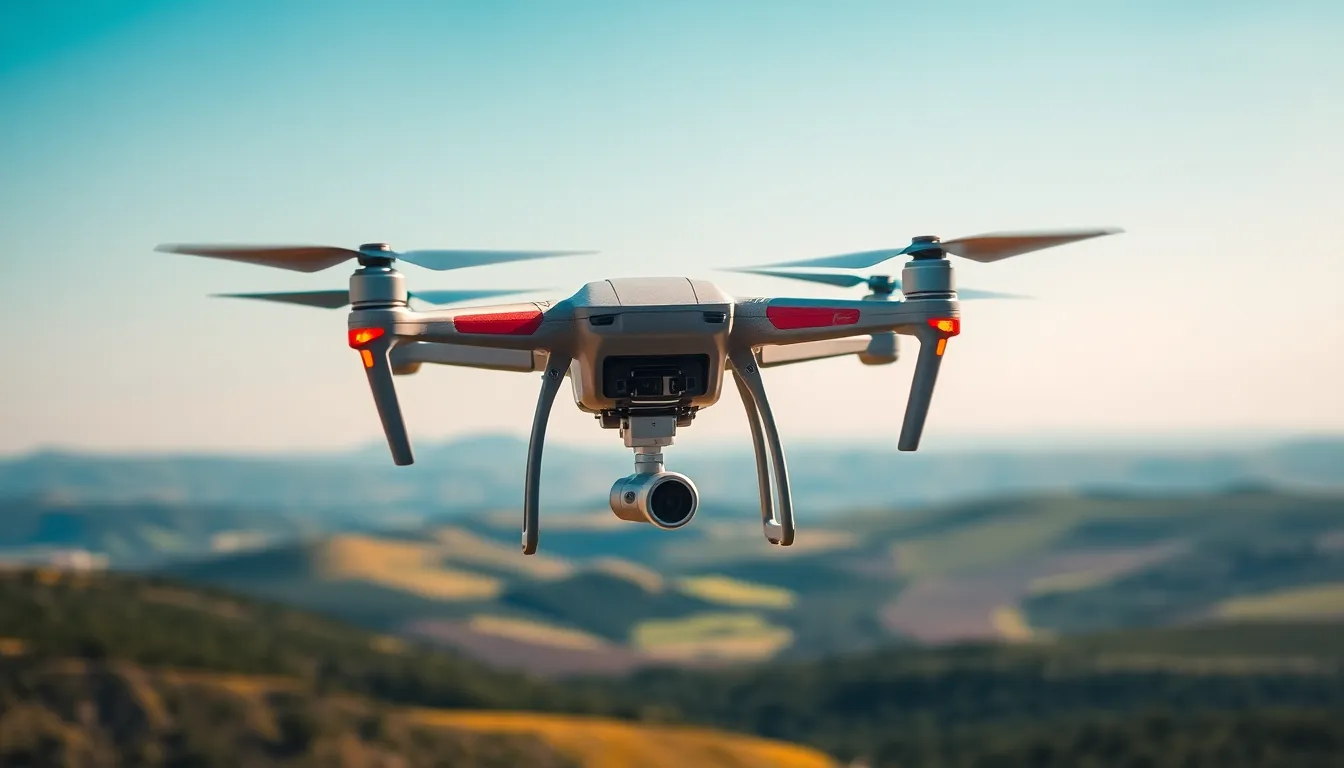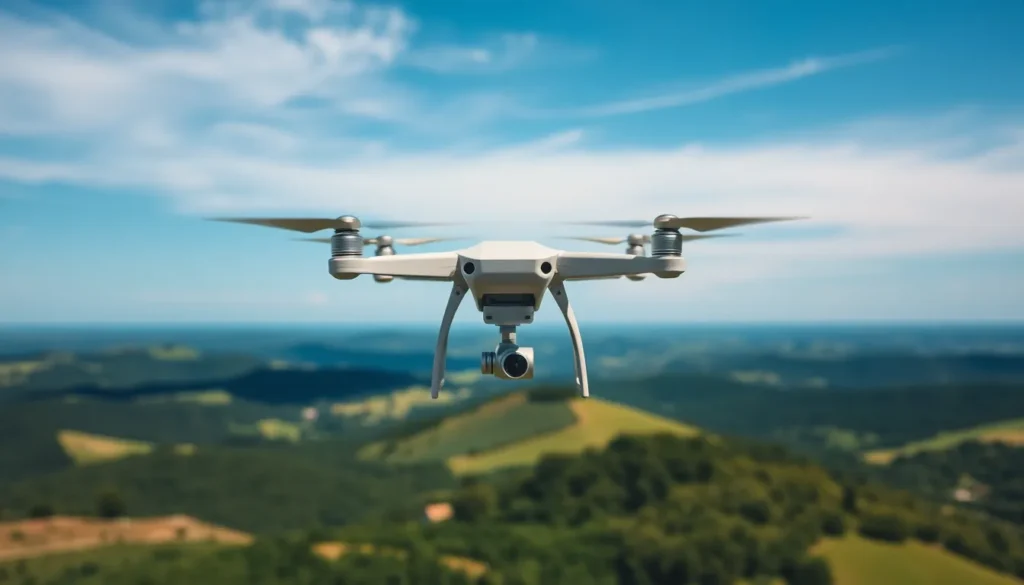In the world of aerial photography, shaky footage is the enemy. Imagine capturing breathtaking landscapes only to find your video looks like a rollercoaster ride gone wrong. That’s where drone image stabilization swoops in like a superhero, saving the day and your footage. With the right stabilization technology, those jarring movements transform into smooth, cinematic masterpieces that even Spielberg would envy.
But it’s not just about looking good; it’s about making your content stand out in a sea of shaky selfies and blurry family vacations. Whether you’re a hobbyist or a seasoned pro, mastering drone image stabilization can elevate your work from “meh” to “wow” in no time. Dive into the world of stabilization techniques and discover how to keep your shots steady, your audience captivated, and your reputation as a drone wizard firmly intact.
Table of Contents
ToggleOverview of Drone Image Stabilization
Drone image stabilization significantly improves the quality of aerial footage. This technology minimizes the effects of movement, ensuring smoother video playback. Various methods, such as mechanical, electronic, or optical stabilization, exist to address motion blur.
Gyroscopic sensors play a crucial role in stabilization systems. These sensors detect changes in orientation, which helps the drone adjust in real time. Some drones use gimbals, which mechanically balance the camera, maintaining its level regardless of drone movement. Others employ digital stabilization, where software algorithms enhance footage post-capture.
Stabilization advantages are clear for both hobbyists and professionals. Smooth footage creates a more engaging viewing experience. High-quality shots can elevate a creator’s content, allowing them to stand out in a competitive market. Furthermore, effective stabilization reduces the need for extensive editing, saving time in post-production.
Advanced features like horizon leveling and altitude hold enhance stabilization systems. Horizon leveling ensures the horizon remains straight, while altitude hold maintains a consistent height during filming. These features contribute to achieving cinematic-level results with minimal effort.
Mastering drone image stabilization matters significantly in aerial photography. Creators equipped with stabilization techniques can consistently produce high-quality content, making a strong impression on their audience. Transitioning from shaky to smooth footage ultimately enhances their overall storytelling ability.
Importance of Stabilization in Drone Photography

Drone image stabilization plays a crucial role in enhancing the overall effectiveness of aerial photography. Creators rely on it to produce crisp, visually appealing footage that captures the audience’s attention.
Impact on Image Quality
Improved stabilization techniques lead to higher image quality in drone footage. Motion blur diminishes due to effective stabilization methods, resulting in clearer images. This clarity becomes especially important in professional contexts where details matter. Creators benefit from fewer distractions in their visuals. Effective use of gimbals and gyroscopic sensors allows real-time adjustments for consistent sharpness. By employing modern stabilization technology, videos achieve cinematic quality, making them more appealing to viewers. Filmmakers report that a smooth transition from one shot to another significantly enhances storytelling without distracting flaws.
Effects on User Experience
User experience improves substantially with stabilized drone footage. Smooth motion engages viewers, preventing nausea or discomfort often caused by shaky video. Consistency across scenes allows audiences to follow narratives seamlessly. Creators note that viewers are more likely to share engaging, high-quality content. Enhanced footage leads to better perceptions of professionalism, which builds trust with the audience. Moreover, less need for extensive post-production editing streamlines workflow, allowing creators to focus on actual storytelling. Ultimately, a positive user experience results in increased viewer retention and satisfaction.
Techniques for Drone Image Stabilization
Drone image stabilization employs various techniques to enhance video quality. These methods ensure smoother footage and a more engaging viewing experience.
Mechanical Stabilization Systems
Mechanical stabilization systems use physical devices to minimize vibrations and unwanted movement. Gimbals, a common example, allow drones to maintain a stable orientation regardless of the operator’s movements. Three-axis gimbals are particularly effective as they balance the camera in three different directions. This technology absorbs shocks from drone maneuvers, ensuring crisp imagery. Users often find that this results in stunning aerial shots. The effectiveness of mechanical systems relies on their ability to counteract sudden shakes, producing professional-quality footage.
Electronic Stabilization Systems
Electronic stabilization systems adjust footage digitally after capturing it. These systems leverage gyro sensors to detect motion, correcting distortions in real-time. Software algorithms smooth out shaky footage, creating an illusion of stable camera movement. Digital stabilizations, such as those found in advanced editing software, prevent excessive cropping, preserving field of view. Significant improvements occur when combining electronic stabilization with high-quality cameras. Heavily relied upon in various scenarios, electronic systems provide users with the flexibility to enhance their footage without additional equipment.
Challenges in Drone Image Stabilization
Drone image stabilization faces several challenges that can impact the quality of aerial footage. Understanding these issues is crucial for improving overall effectiveness.
Wind and Weather Conditions
Wind conditions often disrupt stable aerial footage. Strong gusts can lead to significant shaking, making stabilization efforts less effective. Weather factors like rain or snow also complicate drone operations. Moisture may affect equipment performance, causing additional instability during filming. High winds can create turbulence that even advanced stabilization systems struggle to correct. Thus, preparation for varying conditions becomes essential for achieving smooth results.
Movement and Vibrations
External movements significantly influence drone stability. Any physical vibrations from the drone’s propellers can introduce unwanted motion, complicating stabilization. Quick directional changes during maneuvers further exacerbate this issue, as it may exceed the limits of stabilization systems. Ground vibrations from nearby activities also affect footage quality. To achieve optimal results, operators must routinely conduct thorough maintenance on their equipment to minimize inherent vibration issues. Utilizing high-quality stabilization techniques helps counteract these challenges, ensuring clearer visual outcomes.
Mastering drone image stabilization is vital for anyone looking to elevate their aerial photography. By utilizing effective stabilization techniques, creators can produce visually stunning footage that captivates audiences and enhances storytelling. The integration of mechanical and electronic stabilization methods ensures smoother playback and reduces the need for extensive post-production edits.
With the right tools and techniques, drone operators can navigate challenges posed by environmental factors while delivering professional-quality content. Investing time in understanding and implementing these stabilization strategies not only improves the quality of video but also strengthens the creator’s reputation in a competitive landscape. Ultimately, embracing drone image stabilization is a game-changer for anyone serious about aerial videography.

